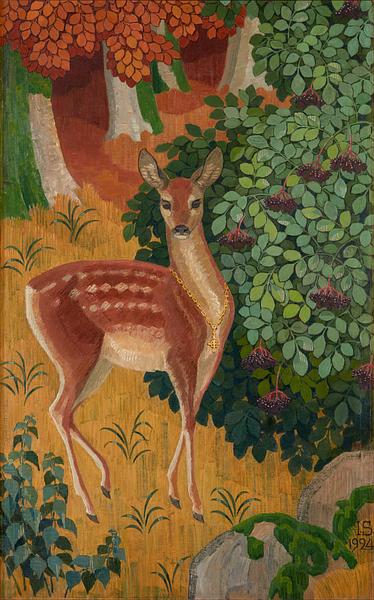Joakim Skovgaard (1856–1933)
The Maiden in the Deerskin, 1924
Oil on canvas
158 x 99.5 cm
Throughout his career, Joakim Skovgaard received numerous commissions in Denmark for altarpieces, frescoes, stained glass windows, tapestries and murals on walls and ceilings. In the late 1910s, he was asked to create six compositions depicting scenes from Danish folk ballads for use on tapestries to adorn the tower hall at Christiansborg Palace. The creation of The Maiden in the Deerskin was prompted by this task.
In the painting, a deer is at the centre of the composition, fixing its eyes on the viewer. Around its neck it wears a Celtic cross on a gold chain. The animal is set amidst a dense and lush natural setting with a forest floor in autumn colours and a bushy elderberry tree carrying heavy bunches of dark, ripe berries. Skovgaard has depicted a scene from the folk ballad The Maiden in the Deerskin (Jomfruen i Hindeham),[1] the fateful tale of how Sir Peder ignores his mother’s warnings and shoots the wild deer roaming the forest. He should have heeded her words as the deer is in fact the enchanted animal form of his sister, but he only realises this when he begins to skin it.
In his painting, Skovgaard has chosen to portray a scene that precedes the ballad’s climax, opting to show the moment just before the deadly shot. Why this scene was not included in the final tapestries is unknown. We do, however, know that Skovgaard did not abandon his plans to incorporate a scene from this particular ballad. The scene eventually featured among the tapestries had another, and most dramatic, focus: Skovgaard depicted the fatal moment when the enchantment is lifted as Sir Peder begins to skin the dead deer.[2]
Not being a weaver himself, Skovgaarad created preliminary works in the form of full-scale cartoons in the same size as the final tapestries. A team of weavers, led by Skovgaard’s daughter, Georgia Skovgaard (1893–1973), were then tasked with weaving the tapestry in accordance with the design provided on the cartoon. By 1929, all the tapestries were finished, and they are still on display in the tower hall in Christiansborg, now part of the royal reception rooms.
In the painting, a deer is at the centre of the composition, fixing its eyes on the viewer. Around its neck it wears a Celtic cross on a gold chain. The animal is set amidst a dense and lush natural setting with a forest floor in autumn colours and a bushy elderberry tree carrying heavy bunches of dark, ripe berries. Skovgaard has depicted a scene from the folk ballad The Maiden in the Deerskin (Jomfruen i Hindeham),[1] the fateful tale of how Sir Peder ignores his mother’s warnings and shoots the wild deer roaming the forest. He should have heeded her words as the deer is in fact the enchanted animal form of his sister, but he only realises this when he begins to skin it.
In his painting, Skovgaard has chosen to portray a scene that precedes the ballad’s climax, opting to show the moment just before the deadly shot. Why this scene was not included in the final tapestries is unknown. We do, however, know that Skovgaard did not abandon his plans to incorporate a scene from this particular ballad. The scene eventually featured among the tapestries had another, and most dramatic, focus: Skovgaard depicted the fatal moment when the enchantment is lifted as Sir Peder begins to skin the dead deer.[2]
Not being a weaver himself, Skovgaarad created preliminary works in the form of full-scale cartoons in the same size as the final tapestries. A team of weavers, led by Skovgaard’s daughter, Georgia Skovgaard (1893–1973), were then tasked with weaving the tapestry in accordance with the design provided on the cartoon. By 1929, all the tapestries were finished, and they are still on display in the tower hall in Christiansborg, now part of the royal reception rooms.
Inv. no. B 483
Published in:
Unpublished;
